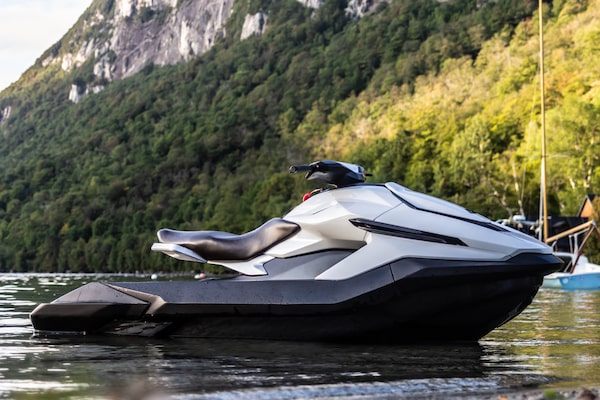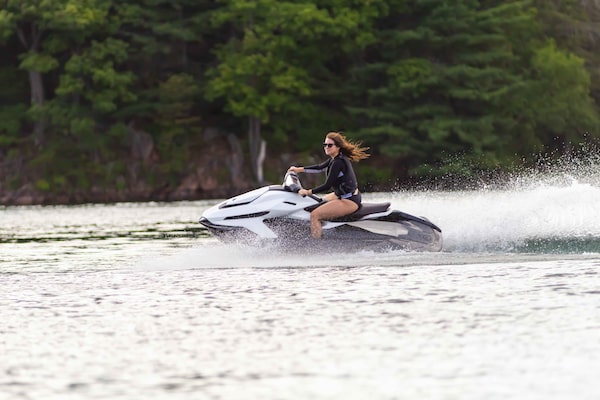
The Taiga Orca is among the world's first electric personal watercraft.Courtesy of manufacturer
Skipping like a stone across a lake at 70 kilometres an hour on what amounts to a jet engine with a seat, you really do have to hold on tight.
Waves that look innocuous – waves you never even see – send the craft up into the air and then crashing back down with a smack. The machine takes it in stride, accelerating forward on the wide open expanse of Lake Ontario, where there’s no traffic to slow you down nor roads to dictate where you go. It’s the ultimate in freedom, it’s exhilarating – and also strangely quiet.
The impossible-to-ignore, chainsaw-in-a-tumble-dryer noise typical of jet-powered personal watercraft – a noise that is sure to get cottagers up in arms – is absent here. There’s no whiff of gasoline or exhaust fumes, either. This jet is electric.
The Orca, from Montreal-based Taiga Motors Inc., is among the first electrically powered personal watercraft (PWC) in the world. This is from the same company that recently launched an electric snowmobile. As Tesla has done for cars, Taiga is aiming to do for the powersports market.

Visually, the Orca is reminiscent of traditional gas-powered PWCs such as BRP's Sea-Doo.Courtesy of manufacturer
The Orca prototype looks similar to BRP’s Sea-Doo and Kawasaki’s Jet Ski, except it has a charge port hidden under a cover just in front of the seat. The top-of-the-line Founders Edition model also has a hull made of carbon fibre that glistens in the sun.
“We can have all the fun of a [personal watercraft] without the drawbacks,” says Sam Bruneau, co-founder and chief executive officer of Taiga Motors. Noise and maintenance are the two big drawbacks to traditional PWCs, he noted, as well as pollution.
Electric watercraft make a lot of sense as a concept, but the technology to make them work is complex. The batteries and motor have to operate in 60-degree heat and extreme humidity inside a boat’s sealed hull and be able to withstand repeated slams into waves with no suspension to take the edge off the impact. And, in the event of a crash, you need to ensure water doesn’t conduct electricity from the battery.
“There’s a lot of development you need to do that’s new, that hasn’t been done,” Bruneau says, adding that the small team at Taiga think they’ve cracked it.

A Taiga Orca speeds along Lake Ontario, near Toronto.Courtesy of manufacturer
The Orca is indeed quiet at about 65 decibels, Bruneau says. (Normal conversation typically measures about 60 decibels and a lawn mower emits 90 decibels.) It’s impossible to judge while riding the Orca how much quieter it sounds on shore, but a gas-powered watercraft can emit anywhere from 75 to 95 decibels. It was partly on noise grounds that proposed federal legislation in 2003 would have allowed communities to ban or restrict PWCs. However, the bill was never passed into law.
As for maintenance and winter storage, there’s very little to do since the lithium-ion battery and electric motor are a sealed unit inside the sealed hull. Taiga offers a five-year, no-maintenance warranty on the Orca. Come winter, all you have to do is pull it out of the water, Bruneau says.
There’s no chance of spilling gasoline or oil into the water and no local exhaust-pipe emissions because, well, there is no exhaust pipe.
Electric power does comes with its own drawbacks, though. For one thing, it’s more expensive. Prices range from $18,000 to $29,000 for the carbon-fibre Orca Carbon. Even the most affordable model is at the upper end of the price range of gas-powered PWCs.

A digital display provides riders with information on battery range and speed.Courtesy of manufacturer
The battery on all Taiga models is good for about two hours of riding, or less than an hour if you’re going flat out, and a full recharge from a 240-volt outlet takes two hours. The Orca can also use automotive DC fast chargers to get an 80-per-cent charge in 20 minutes. It’s designed so you can safely leave it plugged in even in the pouring rain, Bruneau says.
While 20 per cent of the snowmobile market is commercial use, over 90 per cent of the PWC market is recreational, he explains. Sea-Doos and Jet Skis are weekend toys, so range isn’t as critical. Even when the Orca’s battery gauge is on empty, there’s still enough charge to take you a few kilometres back to shore.
With 120 or 180 electric horsepower on tap, depending on the model, its performance should be comparable to high-end, gas-powered PWCs that have as much as 300 hp. The relatively light 580-pound Orca has a similar power-to-weight ratio.
My wrists, sore from death-gripping the handlebars, can attest to the fact that the Orca – even the down-on-power prototype I rode – was plenty quick.
These machines were designed to thrill. It was a motocross racer named Clayton Jacobson who, while recovering from a nasty crash, wondered whether there might be some way to experience the thrill of motorcycle riding without the danger of crashing into hard and unforgiving things, like trees or the ground.

At just 580 pounds, the Orca has a similar power-to-weight ratio to many high-end gas-powered PWCs.Courtesy of manufacturer
Since the late 1960s, they’ve been powered by two- and four-stroke gas engines. Today, Taiga isn’t the only company that thinks electric watercraft would make a lot of sense.
In 2018, Hungarian company Narke launched an electric PWC that looks like a stealth fighter and costs a whopping €44,000 ($68,000). Nikola Motors, would-be maker of hydrogen and electric trucks, is selling an electric PWC too, but there’s precious little information about the Wav other than the fact you can reserve one now.
Quebec-based BRP – a major player in the powersports industry – showed off an electric Sea-Doo concept last year. “We aren’t ready to say when this will come to market yet,” Sandy Scullion, a senior vice-president at BRP, said in an e-mail.
Taiga plans to ship the first Orcas to customers in spring 2021, Bruneau says, through a network of existing watercraft dealerships across Canada, the United States and Europe.

Taiga plans to ship the first Orcas to customers in spring 2021.Courtesy of manufacturer
COVID-19 delayed the start of production, which was scary for a startup, Bruneau says. They didn’t know how long the shutdown would last, but their Quebec factory is now running, and he says the company is funded through to the end of 2021. Despite the pandemic, he’s confident the recent headlines made by Nikola Motors and Tesla – the latter is now the world’s most valuable car company – will give a boost to an electric upstart such as Taiga as it plans its next funding round. “There’s a lot of interest in this space,” he says.
In Canada, sales of personal watercraft skyrocketed in May and June after a dip in April when the pandemic forced many dealers to close, according to data from the National Marine Manufacturers Association (NMMA) Canada, which represents all major PWC manufacturers.
As families this year opt for a staycation, they are taking the money they would have spent on travelling abroad and buying a boat instead, said Sara Anghel, president of NMMA Canada. More than 12 million Canadians enjoy boating, she added.
After a brief taste, we can report that there may be no more thrilling way to distance yourself from human contact than straddling a jet engine and skimming across the surface of a lake. And if you can keep the noise down with an electric craft, you might find you have more friends when you get back to shore.
Shopping for a new car? Check out the new Globe Drive Build and Price Tool to see the latest discounts, rebates and rates on new cars, trucks and SUVs. Click here to get your price.
Stay on top of all our Drive stories. We have a Drive newsletter covering car reviews, innovative new cars and the ups and downs of everyday driving. Sign up for theweekly Drive newsletter, delivered to your inbox for free. Follow us on Instagram,@globedrive.